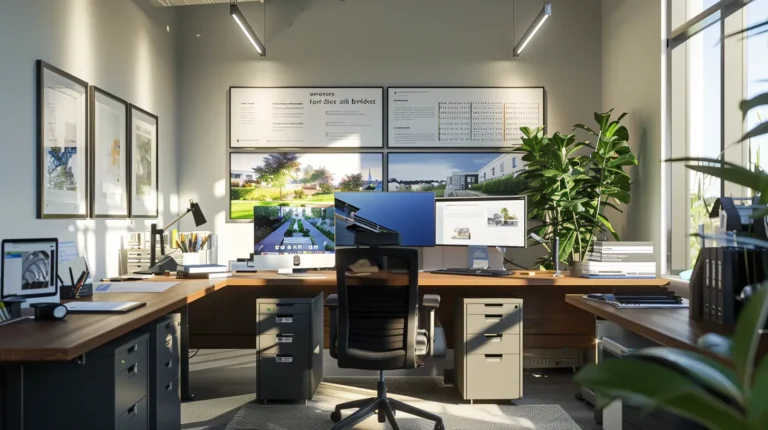Heads Up: When you purchase through links on our site, we may earn an affiliate commission at no cost to you.
Top maintenance tips for keeping a realtor site updated are essential for ensuring your website is a living asset. Treat it like a listing that needs regular showings and tidy touchups. Set a simple cadence—weekly for listings, monthly for blogs, quarterly for technical checks—so nothing goes stale. Small, steady updates keep pages fast, accurate, and trustworthy on mobile and desktop.
Think in buyer/seller paths as you maintain. Buyers need fresh photos, accurate status, and a clear “Book a Tour.” Sellers want recent market context, an easy “Get Your CMA,” and proof near the button. Keep those actions visible, trim extra clicks, and log each change so you can see what moved conversions over time.
Key Takeaways
- Update market data to keep listings and blog posts accurate.
- Improve site usability through layout adjustments and mobile tests.
- Refine meta details and keyword research for better search performance.
- Monitor performance metrics to maintain an efficient user experience.
- Integrate chatbots and virtual tours for improved client interactions.
Regularly Update Website Content to Engage Visitors

Commit to a lightweight content routine. Refresh listings first, then revisit high-traffic blogs, and finally review compliance notes. Each pass should remove friction, add clarity, and support a single next step—tour request, saved search, or CMA. Keep a short changelog so you can tie updates to shifts in traffic and leads.
Refresh Listings With Current Market Data
Make listings your weekly priority. Sync prices and status changes with your MLS feed, expire sold/withdrawn properties, and surface “price drop” or “new” badges for recency. Tighten the above-the-fold block: price, beds/baths, neighborhood, quick facts, and one strong CTA. Add a visible “Last updated” date so buyers trust what they’re seeing.
Strengthen the asset with clean media and context. Compress images, keep galleries consistent in aspect ratio, and caption photos that need explanation (garage depth, yard size, storage)—link to the neighborhood page, recent comps post, and a disclosure packet. Place your primary button after the gallery and near the bottom so the next step is close at hand on phones.
Update Blog Posts With New Information and Trends
Adopt a quarterly refresh cycle for posts that rank or convert. Recheck facts, update outdated screenshots, and incorporate local data (new school zones, tax changes, and inventory shifts). Rewrite intros to match search intent today, add a clear “Updated on [Month Year]” line, and place a single CTA that matches the topic—saved search for buyer guides, CMA for seller pieces.
Use each refresh to strengthen internal links—point neighborhood guides to current listings and back to a pricing page. Fold in a short FAQ that answers real questions from chat or email. Trim fluff, tighten headings, and break long sections into scannable chunks so readers get to the action faster.
Ensure Compliance With Local Real Estate Regulations
Keep a simple checklist and review it monthly—display the brokerage name, license numbers, and Fair Housing language as required by your state. Add consent language for email/SMS forms, link a plain-English privacy policy, and keep cookie/consent banners unobtrusive but present. Make contact details easy to find on every page.
Watch MLS display rules and advertising boundaries. If you show IDX data, follow attribution and watermark requirements and avoid claims that could be read as guarantees. Aim for accessible pages: readable contrast, alt text on key images, keyboard-friendly forms, and descriptive labels. This protects visitors, preserves trust, and reduces the need for cleanup later.
- Instant feedback
- Valuable insights
- Actionable tips
Optimize Website for Mobile Responsiveness

Most of your traffic scrolls on a phone. Build for thumbs first, desktops second. Keep pages light, buttons obvious, and key actions always in reach. If a buyer can’t tap “Book a Tour” without pinch-zooming—or a seller can’t find “Get Your CMA” in two seconds—you’re leaking leads.
Adjust Layout for Various Screen Sizes
Use a fluid grid so sections reflow cleanly from wide monitors to small phones. Stack content in a simple order: headline → quick facts → gallery → details → CTA. Keep type sizes readable and line lengths short. Give buttons generous padding and space between taps so people don’t bump the wrong link.
Surface the important stuff early. On listings, show price, beds/baths, neighborhood, and one strong button above the fold. On valuation pages, keep the address field and contact method up top with zero distractions. Add a “Back to results” link on every property page so shoppers don’t feel trapped. Test common breakpoints (320, 375, 390, 414, 768, 1024) and fix any odd wraps or overlaps before you hit publish.
Test Load Speed on Mobile Devices
Speed sells. Run your top pages through mobile speed tests and watch the same metrics every week: first render, interaction delay, and layout shift. Compress images, convert to modern formats, and lazy-load anything below the fold. Defer chat, maps, and analytics extras until after the first paint. Preload only the fonts you actually use.
Then test on a real phone over cellular, not just Wi-Fi. Click through the full path—search → results → listing → CTA → form → confirmation. If any step stalls, trim scripts or swap the widget. Fix listing and valuation templates first; they sit closest to the money.
Implement Touch-Friendly Navigation Features
Design every flow for one thumb. Use a clear, sticky action bar after the first scroll—“Book a Tour” on listings, “Get Your CMA” on seller pages. Make tap targets at least finger-sized and keep 8–12px of breathing room around them. Replace hover menus with simple, tap-to-open panels. Put search, filters, and the map one tap away.
Help forms go faster: numeric keypad for phone and price fields, address autocomplete, and two preset tour windows. Avoid tiny links, edge-to-edge taps near the phone’s system gestures, and carousel arrows that require precision. The easier the tap, the more leads reach your inbox.
Improve Search Engine Optimization Strategies

SEO keeps your pipeline steady. Start with pages that match intent—“homes for sale in [city],” neighborhood guides, and “sell my house in [city].” Build clean internal links between those hubs and your listings, valuation page, and contact forms. Keep pages fast on mobile and make each one point to a single next step.
Local signals matter. Keep NAP consistent in the footer, add schema that search engines understand, and use clear titles/metas that promise value. Review your data weekly so you can spot wins, tighten weak spots, and publish the next page with less guesswork.
Conduct Keyword Research for Real Estate Terms
Work from buyer and seller intent, not a random list. For buyers, target phrases like “homes for sale in [neighborhood],” “new listings [city],” and price-point pages such as “condos under ₱[amount] in [city].” For sellers, focus on “sell my house [city],” “home value [city],” and “best realtor for [area].” If you court investors, add “cash buyers [city],” “duplex for sale [city],” and “[city] cap rates.”
Mine what already works. Open Search Console, sort by clicks, then by impressions. Group close variants and map each group to one page. If you have two pages competing, consolidate the weaker one and redirect it so authority rolls up.
Build a small plan you can actually ship. Aim for three page types each month: a neighborhood page, a price-point page, and one seller resource that ties to your CMA funnel. Link new pages from your homepage, relevant listings, and your main “Buy/Sell” hubs so they get crawled fast.
Update Meta Descriptions and Title Tags
Write titles that read like plain English and promise an action. Keep them tight: “Homes for Sale in [Neighborhood] | [Brand]” or “What’s My Home Worth in [City]? Free CMA.” Use one main keyword near the front and your brand at the end. No stuffing. No repeats.
Metas should set expectations and invite the click. Aim for one benefit + one detail + one action: “See current listings, photos, and tour times. Updated daily. Book a tour.” For seller pages: “Get a pricing range in minutes. Local comps and a fast follow-up. Request your CMA.”
Tune at scale with patterns. Create a simple format for listings, neighborhoods, and seller pages so updates are quick. When a page starts to rank, refresh the meta with a fresher hook—inventory count, new price band, or “Updated [Month Year]”—and watch CTR.
Optimize Images With Alt Text
Treat every image like content. Use short, specific alt text that helps a screen reader and supports the topic: “Kitchen with quartz counters and island, 123 Oak St, [Neighborhood]” or “Map of [Neighborhood] showing parks and schools.” Keep it under ~125 characters. Skip stuffing keywords; describe what’s on screen.
Clean up the files before uploading. Convert to WebP, resize to sensible dimensions, and name files clearly (“123-oak-st-kitchen.webp” beats “IMG_0042.jpg”)—Lazy-load below-the-fold images so your hero and CTA appear fast.
For videos and tours, add a caption and a summary right under the player. Use VideoObject schema on pages where the clip does heavy lifting (listing showcases, seller explainers). Fast, well-described media keeps visitors engaged and helps those pages earn clicks in search.
Maintain a Secure and Efficient Website

Security and speed are maintenance work you can’t skip. Patch fast, back up on a schedule, and watch your vitals the way you watch comps. A tidy stack keeps pages quick, forms working, and leads safe.
Regularly Update Security Plugins and Tools
Set a simple patch rhythm and stick to it. Update WordPress core, theme, and plugins weekly. Remove anything you don’t use—dead plugins slow down pages and leave security holes. Before big changes, flip your staging site first. If nothing breaks, ship to production the same day.
Lock the front door. Turn on MFA for every user. Use strong, unique passwords and limit the number of roles you have. Add a web application firewall, limit login attempts, and hide or rate-limit the login page. Turn on automatic minor updates for security releases so you’re not waiting on a calendar.
Keep watch. Turn on alerts for file changes and suspicious logins. Review user accounts monthly and prune anyone who no longer needs access. Keep PHP and your web server stack current. Small habits here prevent the late-night fire drill later.
Back Up Data to Prevent Loss
Backups are your safety net. Run daily database backups and a full site backup at least weekly. Store copies off-site, not on the same server. Encrypt them, label them clearly, and keep a rolling history so you can roll back past yesterday’s mistake.
Test restores on a schedule. A backup you’ve never restored is a wish, not a plan. Do a quarterly test on staging: restore the database, uploads, and config; load a few pages; submit a form. Fix what’s missing now, not during an outage.
Snapshot before you tinker. Take a fresh backup before plugin installs, theme updates, and major content imports. Exclude cache folders so files stay small. If your leads live in a CRM, export copies monthly anyway—integrations fail and audits happen. A written “break glass” checklist (who to call, where the backups live, how to restore) turns panic into a 15-minute task.
Monitor Site Speed and Performance
Set targets and review them weekly. Watch Core Web Vitals on your top money pages—listing templates, search, valuation/CMA, and contact: track uptime, average response time, and form completion rate alongside those vitals. If conversions dip, your speed usually did first.
Tighten the stack. Use one caching plugin, compress images, convert to modern formats, and lazy-load below-the-fold media. Defer non-critical scripts, preconnect to key domains, and keep third-party widgets on a short leash. If a tool slows listing pages or hides your main CTA on mobile, cut it.
Measure on real phones over cellular. Click the full path: results → listing → gallery → CTA → form → confirmation. If anything stalls or jumps, fix that template before touching the blog. Document each change and its impact. Small speed gains add up—and they show up as more tours and CMAs on the calendar.
Enhance User Experience With Functional Design

Good UX makes people act. Strip away clutter, keep choices obvious, and repeat the next step where the intent is most apparent. For buyers, that’s on listing pages near the gallery and floor plan. For sellers, that’s on valuation and “book a consult” screens. Build with simple blocks you can reuse, then review the path on a phone every week. Small layout tweaks here raise click-through and lower drop-off.
Simplify Navigation and Menu Structures
Cut the menu to the essentials: Search, Buy, Sell, Resources, Contact. Nest everything else. Give each hub a short intro and one primary button so visitors know what to do next. On listings, use a clean layout order—headline → quick facts → gallery → details → CTA—and keep a visible Back to results link so shoppers never feel trapped.
Use plain labels that match search intent. “Homes for Sale in [Neighborhood]” beats clever names. Drop duplicate links and tabs that go nowhere. On mobile, swap hover menus for tap-to-open panels and keep items under eight so the list doesn’t scroll forever. If a link gets little usage over two weeks, demote or remove it. The lighter the menu, the faster people reach a lead form.
Use High-Quality Visuals to Attract Attention
Lead with a crisp hero photo or 45–60s highlight video, then a consistent gallery that answers common questions: storage, yard depth, garage, laundry, and recent upgrades. Keep aspect ratios steady so the page doesn’t jump. Add short captions where context helps (“Bedroom 2—morning light, east-facing”). For neighborhoods, show a simple map with parks, schools, and drive times instead of generic stock shots.
Keep media lean. Convert images to modern formats, compress before upload, and lazy-load below-the-fold assets so the CTA appears quickly. Add concise alt text for accessibility and improved search results. Place the primary button directly below the media block; that’s where attention is most concentrated.
Ensure Easy Access to Contact Information
Make it impossible to miss how to reach you. Put phone, SMS, and email in the header and footer, and repeat a compact contact card near major CTAs. Add a short promise beside each option—“Fast reply during business hours”—to calm hesitation. On listing pages, pair Book a Tour with a text link: Questions? Text us. On seller pages, pair Get Your CMA with Pick a time.
Reduce form friction. Ask for name and one contact method first; collect extras after the conversation starts. Use numeric keypads for phone fields and address autocomplete on valuation pages. Test on a real phone: from landing to contact should take under a minute. If it doesn’t, trim fields or move the button higher.
Utilize Analytics for Continuous Improvement

Data should tell you what to fix next. Track the actions that lead to money—searches, listing views, saved searches, tour requests, valuation starts, and consult bookings. Build two simple views in your analytics: buyer path (search → listing → tour) and seller path (address → CMA → consult). Review them on the same day each week and ship one change based on your observations.
Track Visitor Behavior and Interactions
Log real events, not just pageviews. Capture filter use, map moves, gallery swipes, scroll depth to the gallery, clicks on Book a Tour, form starts, and form completes. On seller pages, record address entries, CTA clicks, and “pick a time” actions. Break it all out by device so you can spot mobile friction fast.
Use heatmaps and a handful of session recordings to find stuck spots. If people stall before the gallery, move quick facts and media higher. If they exit on the form, cut fields and add a short trust line (“Fast reply during business hours”). Keep privacy in mind: mask inputs and avoid storing sensitive data in recordings.
Analyze Conversion Rates for Lead Generation
Create a baseline for each key template: listings, search, neighborhood pages, valuation/CMA, and contact. Track the start rate, form completion rate, and click-through rate to your primary CTA. Then watch two global KPIs every week—speed to first reply and appointments booked. Those two numbers predict pipeline health better than any vanity metric.
Slice results by traffic source and landing page. If PPC drives visits but few tour requests, your landing page needs a simpler layout and a higher CTA. If organic brings lots of readers but few CMAs, add a short valuation explainer and repeat the button near the top and bottom. Always tag campaigns with UTMs so wins are obvious.
Use Data to Adjust Marketing Strategies
Turn insights into one clear fix at a time. Move the Book a Tour button above the gallery, shorten the valuation form to name + one contact method, or add a 45–60s video to the top third of a high-traffic listing. Give each change a week, then keep the winners and roll back the losers.
Let data guide content and spend. Double down on neighborhoods and price points that lead to tours. Shift ad budget to pages with the best consult rate. When a page ranks but lags on leads, tighten copy near the CTA and add proof (reviews, response-time note). Rinse and repeat—small, steady lifts compound.
Keep Up With Technology Trends in Real Estate

Adopt tech that shortens the path to a conversation. If a tool helps a buyer book a tour more quickly or facilitates a homeowner’s request for a CMA with less friction, it earns a spot. If it adds clicks, slows pages, or buries your CTA, skip it. Set a quarterly review: test one new feature at a time, measure reply speed and bookings, then keep what moves the numbers.
Consider Integrating Chatbots for Client Interaction
Use chat to route intent in seconds. Start with three buttons—Buy, Sell, Ask a Question—and collect a name plus one contact method within two taps. From there, hand off to a human or a booking link. Keep answers short: link disclosures on listing pages, show this weekend’s tour slots, or send the valuation form on seller pages.
Place the launcher only where it helps: listings, search results, and valuation pages. On mobile, keep the bubble small so it never covers your primary button. Pipe transcripts into your CRM so the record shows the question, your reply, and the page they were on. Review transcripts weekly and fix patterns on-page—if people keep asking about HOA dues or schools, add that info above the fold.
Explore Virtual Tour Technologies
Short videos and 3D tours boost confidence and keep visitors on the page. Lead with a 45–60 second highlight reel (entry, main living, kitchen, primary suite, two hero features), then stack a 3D walkthrough beneath it for deeper exploration. Add one clear step under the player—Book a Tour—and repeat it after the gallery.
Keep files light so pages stay quick on phones. Compress video, lazy-load assets below the fold, and use a clean poster image to ensure fast first paint. Caption key moments in the tour (“South-facing yard,” “Oversized garage,” “ADU potential”) and link to disclosures or a floor plan. Track time on page and tour requests per listing; reshoot or trim clips that don’t lift either metric.
Evaluate New Real Estate Apps and Tools
Once a quarter, trial one tool that could speed bookings or follow-ups—nothing more. Good candidates: scheduling that writes back to your CRM, light AI to summarize inquiries into next steps, or a map module that loads faster on mobile. Stand up a staging page, push five test leads through, and measure two things: time first to reply and appointments set.
Keep what plays well with your stack. Data should flow into your CRM with source tags, page context, and an owner assigned automatically. If a widget adds heavy scripts, breaks your fonts/buttons, or blocks your sticky CTA, remove it. Document each test (date, change, result) so your stack gets smarter every quarter without getting heavier.
Frequently Asked Questions
How do I update content on my realtor site regularly?
Set a simple cadence and stick to it: listings weekly, top blog posts monthly, technical checks quarterly. Keep a one-page calendar with owners and due dates. On each pass, do three things: fix facts (price/status, school zones, tax items), tighten copy for skimmers, and link to a single next step (Book a Tour, Save Search, Get Your CMA). Track what you changed in a short changelog so you can tie edits to bumps in traffic or leads later.
How can I ensure my site works well on mobile devices?
Design for one thumb. Put price, beds/baths, neighborhood, and a clear button above the fold on listings; put the address field and contact method at the top of valuation pages. Use big tap targets, a sticky action bar after the first scroll, and short forms with numeric keypads and address autocomplete. Test on real phones over cellular—run the full path (results → listing → CTA → form → confirmation) and fix any stall or awkward tap you find.
What SEO Methods Improve Realtor Site Visibility?
Build pages that match intent: “homes for sale in [neighborhood],” price-point pages, neighborhood guides, and “sell my house in [city].” Keep titles plain and useful, and write metas with one benefit + one detail + one action. Add practical schema (Organization/RealEstateAgent, LocalBusiness, BreadcrumbList, VideoObject) and keep alt text short and descriptive. Internally link listings, neighborhood pages, and your CMA page, and monitor Core Web Vitals—speed helps both rankings and conversions.
How do I secure my realtor website effectively?
Patch fast: core, theme, and plugins weekly. Turn on MFA for every user, use least-privilege roles, and add a web application firewall plus rate-limited logins. Back up daily (database) and weekly (full site) to off-site storage, and test a restore each quarter. Remove unused plugins, keep PHP up to date, and set alerts for suspicious logins or file changes. A short “break-glass” checklist (who to call, where backups live, restore steps) turns emergencies into a 15-minute task.
How do analytics help improve site performance?
Measure actions that lead to money, not just pageviews. Log filter use, gallery swipes, clicks on Book a Tour/Get Your CMA, form starts, and completions—split by device and source. Build two simple dashboards: buyer path (search → listing → tour) and seller path (address → CMA → consult). Review them weekly, ship one fix (shorter form, higher CTA, lighter media), and note the result. Small, steady lifts compound into more bookings.
Conclusion
A reliable site comes from simple habits done on a schedule. Keep a staging copy for changes, run weekly backups, and update your theme, plugins, and PHP in batches. Test forms and phone numbers after every update. Watch uptime, SSL, and spam protection. Check Core Web Vitals, image sizes, and third-party scripts to ensure pages load quickly—especially on mobile devices.
Protect your pipeline. Click through key paths each month (homepage → service page → form), fix broken links, and refresh top pages with recent reviews and local proof. Review GA4, GSC, and call logs to spot drops early. Keep roles tight, use 2FA, and store encrypted off-site backups. Small fixes, shipped often, add up to fewer surprises and more leads.
If you want this handled on a set cadence—with backups, safe updates, speed checks, form testing, and reports tied to calls and contracts—you can request a site maintenance and growth plan, and we’ll map a 90-day rollout with clear deliverables and timelines.













